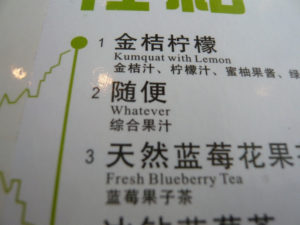Our trademark clients often ask how many trademarks they ought to register in China. The answer is not as straightforward as it may seem.
As an initial matter, companies should register the brands they are actually using (or plan to soon use) and on the goods or services actually in use in China. But sometimes clients are unable to register their actual trademark (either because it was too descriptive or too similar to an existing registration) and instead opt to file applications for a similar trademark they have no intention of ever using. Their rationale is that if they can register the similar trademark, it would block any applications for their actual trademark. This is not an approach I recommend, but it’s not as bizarre as it sounds. Just because their application was rejected doesn’t mean a trademark squatter’s application for the exact same mark would be rejected. CTMO examiners are not bound by previous decisions and their decisions do not always make sense. More on this below.
The more famous the brand, the more likely a trademark squatter will attempt to file a phonetically or orthographically similar mark, so as to take advantage of credulous consumers. This is especially common with the Chinese version of a foreign brand; the Chinese brand name is often new and not well known, so who’s to say which Chinese name is accurate? Companies that can afford it should apply for as many similar trademarks as they can afford, especially Chinese-language marks. See Chinese Brand Names, Copycats, and Soundalikes.
Chinese law also allows (if not implicitly encourages) trademark applicants to file in multiple classes, covering a range of goods and services beyond what the applicant actually provides. We often cite Starbucks as a prime example of a company that has taken full advantage of this strategy by (for example) registering “STARBUCKS” as a trademark in all 45 classes of goods and services. See China Trademarks: Register in More Classes, Take Down More Counterfeit Goods.
Another question is whether companies with a logo that contains some text should file separate applications for both the logo and the text itself. The short answer is yes: filing separate applications for both the logo and the word mark provides more protection than just the logo by itself. You can use the word mark with all fonts and in all contexts, and you won’t need to file a new word mark application if you change your logo (which happens all the time). And though a logo that includes text is typically considered more distinctive than a word mark by itself – and therefore more likely to be registered – the CTMO examiners are unpredictable enough that even this isn’t always true. I was reminded of this recently when we received different decisions on two almost-identical trademarks. One was a word mark that was approved without incident. The other was a slightly stylized version of the word mark that was rejected due to a perceived conflict with a preexisting mark. It makes zero sense that the CTMO issued these two decisions, but consistency has never been that agency’s strong suit.
You never know for sure what will work with the CTMO, but on a sheer numbers basis, the more trademark applications you file, the more likely you are to get one registered.

























